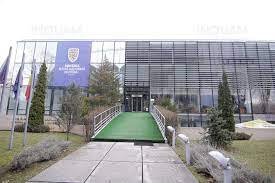 Cable Television (CATV) is a broadcast system of TV programs, FM radio and other services for consumers, using radio frequency signals transmitted to receivers through a fixed network performed with optical fiber or coaxial cable . Cable television appeared alongside the traditional terrestrial television broadcasted in an analogic or digital mode , and alongside satellite television.
Cable Television (CATV) is a broadcast system of TV programs, FM radio and other services for consumers, using radio frequency signals transmitted to receivers through a fixed network performed with optical fiber or coaxial cable . Cable television appeared alongside the traditional terrestrial television broadcasted in an analogic or digital mode , and alongside satellite television.
A CATV network consists of a main terminal , where all the signals are received, and , not taking into account their source the FDM ( frequency- division multiplexing ) is applied , amplified and distributed to the cable network . From a technical standpoint , a modern CATV network involves distributing a number of television channels received and mixed in a central location, to the subscribers of a community, through a branched network made with optical fibers and / or coaxial cables. Broadband amplifiers are also used. Since the late 90s , the most advanced CATV architecture is called „Hybrid fiber coaxial network” which means that a modern CATV network uses optic fiber, as well as coaxial cable.
CATV (Cable Television System) is one of the latest global technologies that can provide a viable support for a wide range of needs , including remote educational process adequately to the needs of teachers and students.
Initially , CATV was created as a unidirectional medium for transmitting TV programs to a maximum number of subscribers at the lowest possible cost. The emission of analogic cable television is achieved through a broadband transmission . In this case, a line terminal equipment placed at one end of the CATV network , transmits number of TV programs on the same cable that the subscriber’s TV receivers are connected to. At first the transmission was unidirectional , making it possible to use amplifiers .
Transforming the CATV cable network in an Internet access network was made possible by dividing the frequency band of a single cable into two parts :
- the low frequency band used for transmitting backwards to the line equipment
(„upstream”); - the high frequency band used for transmitting forward („downstream”) from the line equipment to the subscriber’s TV receivers.
Thus CATV network has evolved from a one-way analog network to a bidirectional digital network as a result of technology development . The advantages are obvious as against old technologies in both the infrastructure ( packing a significantly higher volume of information at the same frequency spacing , greatly improved functional parameters ) and end-user level ( which now features a comprehensive package of services and extended as against the default services of this type of network ) .
A modern CATV network consists of:
- The core network. These devices provide reception , aggregation and processing of analog and digital signals that are to be packed and sent to the end user.
These devices can be antennas and satellite receivers , antennas for reception of analog television and radio programs emitted terrestrially and DVB antennas for receiving packages of programs emitted terrestrially in a digital format.
Also to be found in the central equipment are the equipments specific to structured networks that provide interfacing with Internet Service Providers for subsequent distribution to subscribers.
The signals thus obtained are then levelled as functional parameters and signal quality , packaged , multiplexed and modulated on the frequencies that are specific for the analog and digital CATV channels.
- The Primary Distribution Network (backbone) provides transport for the signals and services packages in the territory. Currently this primary network is made using optic fiber nodes.
- The Secondary Network of Distribution to Subscribers provides transportation between the primary network and the user. Generally this network is structured on coaxial cables and UTP ,having as active elements the line broadband amplifiers and a way back (to allow the bidirectional transfer of information ) .
- The Subscriber Network provides the distribution of signals and user-level services , with equipments that allow users to access the payment services package ( digital receivers , routers, decoding cards prepaid services) .








